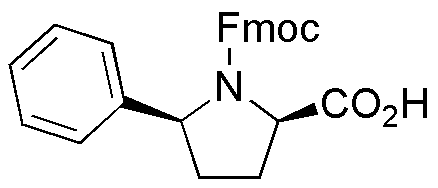Fmoc-(2R,5S)-5-phenylpyrrolidine-2-carboxylic acid is widely utilized in research focused on:
- Peptide Synthesis: This compound serves as a protecting group in the synthesis of peptides, allowing for the selective modification of amino acids without interfering with other functional groups.
- Drug Development: It plays a crucial role in the development of pharmaceutical compounds, particularly in the design of biologically active molecules that target specific receptors.
- Bioconjugation: The compound is used in bioconjugation techniques, facilitating the attachment of biomolecules to surfaces or other molecules, which is essential in creating targeted therapies.
- Material Science: It is applied in the development of advanced materials, such as polymers and nanomaterials, enhancing their properties for various industrial applications.
- Research in Neuroscience: The compound is valuable in neuroscience research for studying receptor interactions and developing potential treatments for neurological disorders.
General Information
Properties
Safety and Regulations
Applications
Fmoc-(2R,5S)-5-phenylpyrrolidine-2-carboxylic acid is widely utilized in research focused on:
- Peptide Synthesis: This compound serves as a protecting group in the synthesis of peptides, allowing for the selective modification of amino acids without interfering with other functional groups.
- Drug Development: It plays a crucial role in the development of pharmaceutical compounds, particularly in the design of biologically active molecules that target specific receptors.
- Bioconjugation: The compound is used in bioconjugation techniques, facilitating the attachment of biomolecules to surfaces or other molecules, which is essential in creating targeted therapies.
- Material Science: It is applied in the development of advanced materials, such as polymers and nanomaterials, enhancing their properties for various industrial applications.
- Research in Neuroscience: The compound is valuable in neuroscience research for studying receptor interactions and developing potential treatments for neurological disorders.
Documents
Safety Data Sheets (SDS)
The SDS provides comprehensive safety information on handling, storage, and disposal of the product.
Product Specification (PS)
The PS provides a comprehensive breakdown of the product’s properties, including chemical composition, physical state, purity, and storage requirements. It also details acceptable quality ranges and the product's intended applications.
Certificates of Analysis (COA)
Search for Certificates of Analysis (COA) by entering the products Lot Number. Lot and Batch Numbers can be found on a product’s label following the words ‘Lot’ or ‘Batch’.
*Catalog Number
*Lot Number
Certificates Of Origin (COO)
This COO confirms the country where the product was manufactured, and also details the materials and components used in it and whether it is derived from natural, synthetic, or other specific sources. This certificate may be required for customs, trade, and regulatory compliance.
*Catalog Number
*Lot Number
Safety Data Sheets (SDS)
The SDS provides comprehensive safety information on handling, storage, and disposal of the product.
DownloadProduct Specification (PS)
The PS provides a comprehensive breakdown of the product’s properties, including chemical composition, physical state, purity, and storage requirements. It also details acceptable quality ranges and the product's intended applications.
DownloadCertificates of Analysis (COA)
Search for Certificates of Analysis (COA) by entering the products Lot Number. Lot and Batch Numbers can be found on a product’s label following the words ‘Lot’ or ‘Batch’.
*Catalog Number
*Lot Number
Certificates Of Origin (COO)
This COO confirms the country where the product was manufactured, and also details the materials and components used in it and whether it is derived from natural, synthetic, or other specific sources. This certificate may be required for customs, trade, and regulatory compliance.

